Log in with a user that has access to the Send in Bulk feature and hover your pointer over the E-sign drop-down in the top navigation bar.
What's New
Get Started
- Quick start guide for administrators
- Quick start guide for users
- For Developers
- Video tutorial library
- FAQ
Administer
- Admin Console Overview
- User Management
- Add, edit, and review active users
- Create function-focused users
- Review users who haven't completed verification
- Check for users with provisioning errors
- Change Name/Email Address
- Edit a user's group membership
- Edit a user's group membership through the group interface
- Promote a user to an admin role
- User Identity Types and SSO
- Switch User Identity
- Authenticate Users with MS Azure
- Authenticate Users with Google Federation
- Product Profiles
- Login Experience
- Account/Group Settings
- Settings Overview
- Global Settings
- Account tier and ID
- New Recipient Experience
- Self Signing Workflows
- Send in Bulk
- Web Forms
- Custom Send Workflows
- Power Automate Workflows
- Library Documents
- Collect form data with agreements
- Limited Document Visibility
- Attach a PDF copy of the signed agreement
- Include a link in the email
- Include an image in the email
- Files attached to email will be named as
- Attach audit reports to documents
- Merge multiple documents into one
- Download individual documents
- Upload a signed document
- Delegation for users in my account
- Allow external recipients to delegate
- Authority to sign
- Authority to send
- Power to add Electronic Seals
- Set a default time zone
- Set a default date format
- Users in Multiple Groups (UMG)
- Group Administrator Permissions
- Replace recipient
- Audit Report
- Transaction Footer
- In Product Messaging and Guidance
- Accessible PDFs
- New authoring experience
- Healthcare customer
- Account Setup / Branding Settings
- Signature Preferences
- Well formatted signatures
- Allow recipients to sign by
- Signers can change their name
- Allow recipients to use their saved signature
- Custom Terms of Use and Consumer Disclosure
- Navigate recipients through form fields
- Restart agreement workflow
- Decline to sign
- Allow Stamps workflows
- Require signers to provide their Title or Company
- Allow signers to print and place a written signature
- Show messages when e-signing
- Require signers to use a mobile device to create their signature
- Request IP address from signers
- Exclude company name and title from participation stamps
- Apply Adaptive Signature Draw scaling
- Digital Signatures
- Overview
- Download and sign with Acrobat /content/help/en/sign/config/admin-managed-sharing.
- Sign with Cloud Signatures
- Include metadata for Identity Providers
- Restricted Cloud Signatures Providers
- Electronic Seals
- Digital Identity
- Report Settings
- New report experience
- Classic report settings
- Security Settings
- Single Sign-on settings
- Remember-me settings
- Login password policy
- Login password strength
- Web session duration
- PDF encryption type
- API
- User and group info access
- Allowed IP Ranges
- Account Sharing
- Account sharing permissions
- Agreement sharing controls
- Signer identity verification
- Agreement signing password
- Document password strength
- Block signers by Geolocation
- Phone Authentication
- Knowledge-Based Authentication (KBA)
- Allow page extraction
- Document link expiration
- Upload a client certificate for webhooks/callbacks
- Timestamp
- Send Settings
- Show Send page after login
- Agreement creation experiences
- Require recipient name when sending
- Lock name values for known users
- Allowed recipient roles
- Allow e-Witnesses
- Recipient groups
- CCs
- Required fields
- Attaching documents
- Field flattening
- Modify Agreements
- Create a copy (of an agreement)
- Agreement name
- Languages
- Private messages
- Allowed signature types
- Reminders
- Signed document password protection
- Send Agreement Notification through
- Signer identification options
- Content Protection
- Enable Notarize transactions
- Document Expiration
- Preview, position signatures, and add fields
- Signing order
- Liquid mode
- Custom workflow controls
- Upload options for the e-sign page
- Post-sign confirmation URL redirect
- Restrict access to shared agreements
- Show Send page after login
- Message Templates
- Bio-Pharma Settings
- Workflow Integration
- Notarization Settings
- Payments Integration
- Signer Messaging
- SAML Settings
- SAML Configuration
- Install Microsoft Active Directory Federation Service
- Install Okta
- Install OneLogin
- Install Oracle Identity Federation
- SAML Configuration
- Data Governance
- Time Stamp Settings
- External Archive
- Account Languages
- Email Settings
- Migrating from echosign.com to adobesign.com
- Configure Options for Recipients
- Guidance for regulatory requirements
- Accessibility
- HIPAA
- GDPR
- 21 CFR part 11 and EudraLex Annex 11
- Healthcare customers
- IVES support
- "Vaulting" agreements
- EU/UK considerations
- Download Agreements in Bulk
- Claim your domain
- Report Abuse links
- System Requirements and Limitations
Send, Sign, and Manage Agreements
- Recipient Options
- Cancel an email reminder
- Options on the e-signing page
- Overview of the e-sign page
- Open to read the agreement without fields
- Decline to sign an agreement
- Delegate signing authority
- Restart the agreement
- Download a PDF of the agreement
- View the agreement history
- View the agreement messages
- Convert from an electronic to a written signature
- Convert from a written to an electronic signature
- Navigate the form fields
- Clear the data from the form fields
- E-sign page magnification and navigation
- Change the language used in the agreement tools and information
- Review the Legal Notices
- Adjust Acrobat Sign Cookie Preferences
- Send Agreements
- Send (Compose) page
- Overview of landmarks and features
- Group selector
- Adding files and templates
- Agreement name
- Global Message
- Completion Deadline
- Reminders
- Password protect the PDF
- Signature type
- Locale for the recipient
- Recipient signature order/flow
- Recipient roles
- Recipient authentication
- Private message for the recipient
- Recipient agreement access
- CC'd parties
- Identity check
- Send an agreement only to yourself
- Send an agreement to others
- Written Signatures
- Recipient signing order
- Send in Bulk
- Send (Compose) page
- Authoring fields into documents
- In-app authoring environment
- Automatic field detection
- Drag and drop fields using the authoring environment
- Assign form fields to recipients
- The Prefill role
- Apply fields with a reusable field template
- Transfer fields to a new library template
- Updated authoring environment when sending agreements
- Create forms with text tags
- Create forms using Acrobat (AcroForms)
- Fields
- Field types
- Common field types
- E-signature fields
- Initials field
- Recipient name field
- Recipient email field
- Date of signing field
- Text field
- Date field
- Number field
- Checkbox
- Checkbox group
- Radio button
- Drop-down menu
- Link overlay
- Payment field
- Attachments
- Participation stamp
- Transaction number
- Image
- Company
- Title
- Stamp
- Field content appearance
- Field validations
- Masked fields values
- Setting show/hide conditions
- Calculated fields
- Field types
- Authoring FAQ
- In-app authoring environment
- Sign Agreements
- Manage Agreements
- Manage page overview
- Copy an Agreement
- Delegate agreements
- Replace Recipients
- Limit Document Visibility
- Cancel an Agreement
- Create new reminders
- Review reminders
- Cancel a reminder
- Access Power Automate flows
- More Actions...
- How search works
- View an agreement
- Create a template from an agreement
- Hide/Unhide agreements from view
- Upload a signed agreement
- Modify a sent agreement's files and fields
- Edit a recipient's authentication method
- Add or modify an expiration date
- Add a Note to the agreement
- Share an individual agreement
- Unshare an agreement
- Download an individual agreement
- Download the individual files of an agreement
- Download the Audit Report of an agreement
- Download the field content of an agreement
- Audit Report
- Reporting and Data exports
- Overview
- Grant users access to reporting
- Report charts
- Data Exports
- Rename a report/export
- Duplicate a report/export
- Schedule a report/export
- Delete a report/export
- Check Transaction Usage
Advanced Agreement Capabilities and Workflows
- Webforms
- Reusable Templates (Library templates)
- Transfer ownership of web forms and library templates
- Power Automate Workflows
- Overview of the Power Automate integration and included entitlements
- Enable the Power Automate integration
- In-Context Actions on the Manage page
- Track Power Automate usage
- Create a new flow (Examples)
- Triggers used for flows
- Importing flows from outside Acrobat Sign
- Manage flows
- Edit flows
- Share flows
- Disable or Enable flows
- Delete flows
- Useful Templates
- Administrator only
- Agreement archival
- Webform agreement archival
- Save completed web form documents to SharePoint Library
- Save completed web form documents to OneDrive for Business
- Save completed documents to Google Drive
- Save completed web form documents to Box
- Agreement data extraction
- Agreement notifications
- Send custom email notifications with your agreement contents and signed agreement
- Get your Adobe Acrobat Sign notifications in a Teams Channel
- Get your Adobe Acrobat Sign notifications in Slack
- Get your Adobe Acrobat Sign notifications in Webex
- Agreement generation
- Generate document from Power App form and Word template, send for signature
- Generate agreement from Word template in OneDrive, and get signature
- Generate agreement for selected Excel row, send for review and signature
- Custom Send workflows
- Share users and agreements
Integrate with other products
- Acrobat Sign integrations overview
- Acrobat Sign for Salesforce
- Acrobat Sign for Microsoft
- Other Integrations
- Partner managed integrations
- How to obtain an integration key
Acrobat Sign Developer
- REST APIs
- Webhooks
- Sandbox
Support and Troubleshooting
Send in Bulk using a parent template.
Send in Bulk allows you to create multiple "child" agreements for one or more recipients using a "parent" agreement template set up by the sender.
The parent template is configured in three parts:
- Defining the Agreement details - Set the agreement name, global message, and base files.
- Defining the Agreement settings - Adjust settings such as reminders, expiration date, password, and localization.
- Add recipients - Enter the recipient list in one of two ways:
- Manual configuration - Type or paste each recipient into the text field.
- Acrobat Pro accounts can only enter recipients manually, with a maximum of 50 recipients.
- CSV Upload – Upload a recipient list using a CSV file.
- Acrobat Pro accounts don't support CSV uploads.
- CSV files can also be used to customize each child agreement.
- Manual configuration - Type or paste each recipient into the text field.
Method of adding recipients
Defining the Agreement details and settings is the same process regardless of how you add your recipients. However, how you intend to add recipients has far-reaching implications for the scope and options applied to the child agreements.
Before you start configuring a Send in Bulk parent template, know and understand which method you intend to use to add your recipients. If you intend to take advantage of the CSV import options, define your CSV before you begin building your template.
The manual configuration allows:
- Only one recipient per child agreement, with an optional counter-signature by the sender. There is no option to add additional external recipients, assign a different counter-signer, or move the counter signature into the first signature position.
- Up to 50 individual recipients can be added through the manual process, generating up to 50 child agreements.
Additionally, all configured agreement details and settings of the parent template apply to all child agreements. This includes:
- the role of the recipient
- the recipient's authentication method and value
- the expiration deadline for the child agreements
- the global message included in the email notification
- the locale used for the recipient experience
The CSV import method provides several practical improvements over the manual process, such as:
- Up to 1,000 child agreements can be configured through one Send in Bulk transaction.
- Up to 100 recipients can be included in each child agreement. Each recipient can have their own:
- Role
- Authentication type (including Email (None), Acrobat Sign auth, Phone (SMS), Password, and Knowledge-based authentication)
- Authentication value
- Private message (up to 1,000 characters)
- Each child agreement can be configured to include:
- Custom agreement name
- Custom "global message" in the email (up to 10,000 characters)
- Custom locale
- Custom expiration date
- Complex workflow structures (Sequential, Parallel, and Hybrid signature flows)
The Send in Bulk features and process are available through multiple interfaces, and your experience will be based on the service you have purchased.
- The Acrobat Standard tier does not have access to Send in Bulk.
- The Acrobat Pro tier does not have direct access to configure access and features.
- Allow up to 50 child agreements.
- Allow reminders to be set.
- Configure a password to protect viewing the completed agreement.
- For Acrobat Sign Solutions and Acrobat Sign for Government
- Have access to a more detailed manual template configuration.
- Have access to CSV upload to further customize individual child agreements.
- Have controls for Send in Bulk that can be enabled at the account and group levels.
Please select the type of service you use from the below options:
-
-
Select Send in bulk.
-
The Select files page loads.
Drag a file into the panel or select one of the options available from the Select files button:
- From Recent - A list of the most recent documents you have accessed in your Acrobat account.
- From Documents - A list of the PDFs on your Documents tab.
- From My computer - Opens a browser for your local system to find and upload a PDF.
- From E-sign templates - A list of the e-sign templates you have created in your Acrobat account.
- From another storage account - Opens a list of third-party networked drives that you can attach to your Acrobat Account for external storage.
-
Once a file is selected, the page refreshes to show the configuration interface for the agreement details.
- Enter up to 50 recipient email addresses.
- Press the return key to enter the email and begin a new one.
- Each email added will generate a discrete child agreement for that individual signer.
- Select the Add me button if you (the sender) also need to sign the agreement.
- Once you are added, you can move your recipient record up or down to sign first or last.
- Select the Add cc button to add a CC'd party who will receive a copy of all completed agreements.
- Up to 11 emails can be added to the CC field.
- Enter up to 50 recipient email addresses.
-
Review the files attached. Add, remove, or reorder the files as needed. The handle on the far left of the file name allows the file to be dragged up or down.
NoteAll files are concatenated into one big PDF, in the order they are listed after the Send in Bulk template is completed.
-
Define the agreement details. This includes:
- The Agreement name - This is used in the subject line of the email delivered to the recipients, so a meaningful name is important.
- The Message - This message is delivered in the body of the email sent to each recipient. This is an opportunity to provide any guidance or context for the agreement.
-
Configure the Agreement settings. There are two options:
- Add a reminder - a reminder email can be sent to every recipient that hasn't completed their signature on a regular cycle that you choose.
- Add an access password - This option installs a password into the PDF that prompts for a password before showing the PDF contents.
-
Once the template is configured and all recipients have been added, select the Next button at the top-right of the window:
-
The document will process for a moment (concatenating all of the files together) and then present the complete PDF in the field authoring environment.
It's recommended to enable Advanced editing if available.
To place fields:
- Select one recipient from the RECIPIENTS drop-down.
- Drag and drop the individual fields from the list of fields on the right into the document where appropriate.
- Be sure to place at least one signature field for each recipient of the agreement.
- Fields assigned to the currently selected recipient will be bright on the page. Fields assigned to any other participant will be greyed out.
-
When all fields are placed, select the Next button at the top-right of the window.
-
A review of the agreement template is presented, showing all of the agreement elements:
-
If everything looks correct, select Send to deliver the agreements.
A post-sending page will be presented, giving you the options to:
- Send another document in bulk - starts the whole process over.
- Manage agreements - Opens your Documents tab with the Bulk sends filter selected.
Select one of these options, or the Close button at the top-right of the window.
-
Log in with a user that has access to the Send in Bulk feature enabled in their primary group and navigate to the Home page.
-
Select the Send in Bulk tile.
If the tile is not present, then the user's primary group does not have Send in Bulk enabled.
Contact your Acrobat Sign administrator to provide access to the Send in Bulk feature for the user's primary group. Contact your Acrobat Sign administrator to provide access to the Send in Bulk feature for the user's primary group. If an error is generated asserting you don't have sufficient access, then the user's primary group isn't configured to allow access Send in Bulk, but the user is a member of a group with access.
Access to the Send in Bulk interface requires the user to have the feature enabled in their primary group. Access to the Send in Bulk interface requires the user to have the feature enabled in their primary group. -
Once the Send in Bulk interface loads:
- Select the group from which the agreements are to be sent. If the group picker isn't available, then you only have access to one group. The group defines:
- the templates available for the transaction
- the signature options and requirements requirements
- the security applied to the agreements
- Select the Choose file button to pick the file that will be used as the base document for the agreement. You can select a file from:
- My computer. Selecting a file from your computer advances the configuration process immediately. If you need to use multiple files, you can select more files after the page refreshes.
- Template Library. Selecting from the Template option allows you to select multiple files from the library by checking the box in the list. Once all files are checked, select the Confirm button to add them to the transaction. The template library has two tabs:
- Templates. This is a listing of all templates available to the user through the group's template library.
- Recent Templates. This is a list of the most recently used templates in the group's template library.
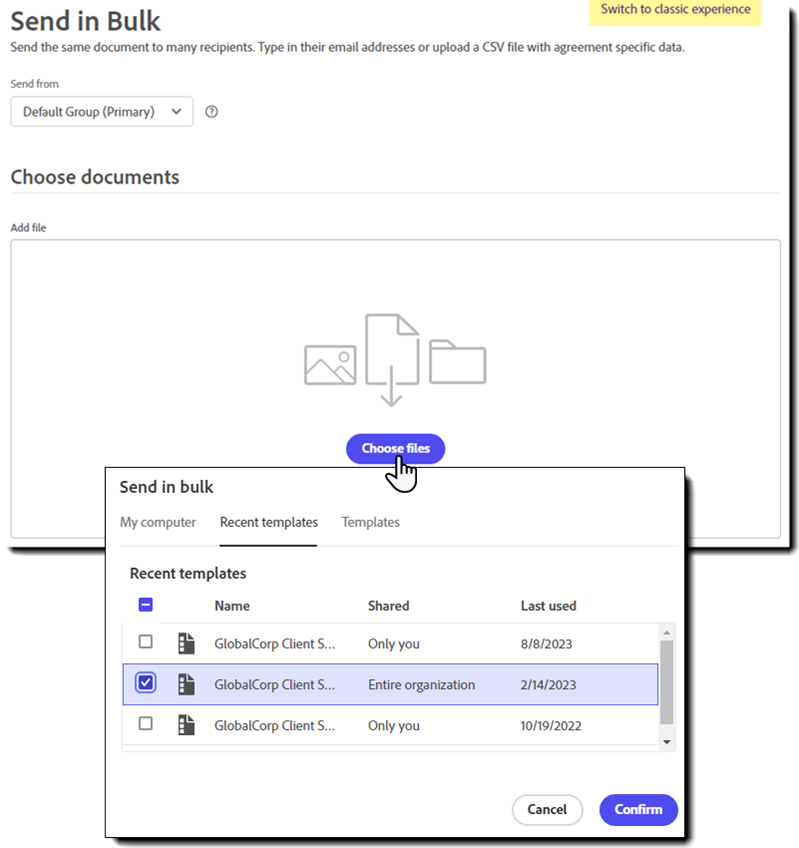
A link may be enabled in the upper-right corner of the window, allowing users to switch to the classic version of the Send in Bulk feature. 
A link may be enabled in the upper-right corner of the window, allowing users to switch to the classic version of the Send in Bulk feature. NoteWhen using templates, it's vital that you test and verify that your template fields are properly assigned and working as expected before you create hundreds of agreements.
- Select the group from which the agreements are to be sent. If the group picker isn't available, then you only have access to one group. The group defines:
-
The page refreshes to show the Agreement details.
There are three sections to review and edit as needed:
- Agreement files - The selected files or templates are already attached. If you need more files attached, select the Choose more files button and add files from your local computer or the template library.
- Files can be added from both sources as needed.
- Files selected from your local system can only be added one at a time. Multiple templates can be selected.
- Agreement name - The name of the agreement appears in the subject line of the recipient's email and is displayed prominently on the Manage page.
- The default Agreement name is imported from the first attached file.
- The agreement name is editable by clicking into the field and typing.
- Message - The message field contains the default global message that is inserted in the email body for all recipients. To edit the message field, click on the field and start typing. The message fields hold up to 10,000 characters.
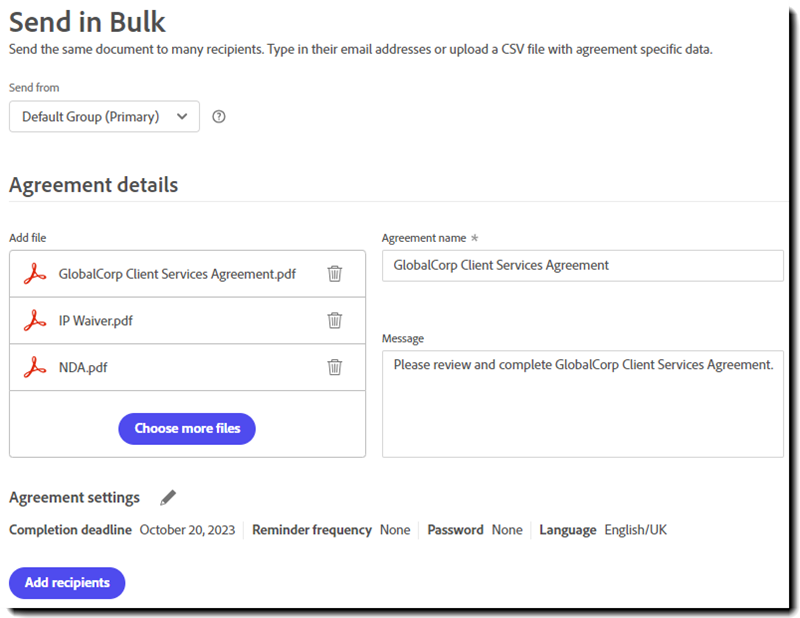

- Agreement files - The selected files or templates are already attached. If you need more files attached, select the Choose more files button and add files from your local computer or the template library.
Configure or adjust the Agreement settings
The default values for the Agreement settings are inherited from the group settings. Each setting can be adjusted to accommodate the purpose of the template.
Based on the service level and group-level settings, different options may be included. Below are the most common:
Verify or configure the Completion deadline.
Depending on the nature of your agreements, you may or may not employ an agreement deadline.
If used:
- The default lifespan of agreements is defined at the group level. If you must edit this value frequently, talk with your admin to see if the default can be adjusted.
- The sender can modify this deadline during agreement composition (if group settings permit).
- Deadlines can be modified on the Manage page by the original sender (if group settings permit).
- Internal signers can be excluded from the deadline cancellation (if configured to do so in the group settings).
- The agreement automatically expires once the deadline is crossed and cannot be signed or completed. A new agreement must be created.
Edit the Completion deadline by selecting the Agreement settings edit icon and picking a new deadline from the calendar.


All agreements expire after being in progress for 365 days if not completed. This expiration deadline cannot be modified or suppressed.
Verify or modify the Reminder frequency.
The reminder frequency defines the cycle when reminders are emailed to the current active recipients for your agreement.
- The default reminder iteration is defined in the group settings.
- A default reminder message can be configured in the group settings.
- The default reminder can be edited during agreement composition (If permitted by group settings).
- Reminders that trigger every day have a 10-day life cycle. All other reminders have a 60-day lifecycle. Reminder lifespans cannot be altered.
- Reminder emails are sent at the same time of day the agreement is initially sent.
- Reminders can be configured on the Manage page after the agreement is sent.
- Recipients are only notified when they are the active participant in the agreement. They are not notified before or after (with the exception of the final notification containing the completed agreement PDF).
Edit the Reminder frequency by selecting the Agreement settings edit icon and picking a new frequency from the dropdown.
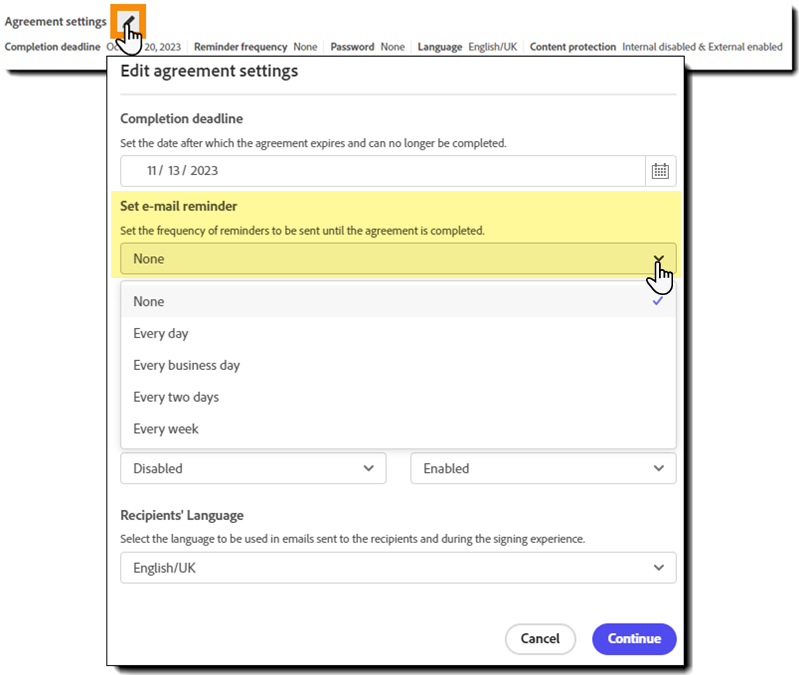

Add a password to view the final PDF.
The password entered into this field is exclusively for viewing the PDF.
- The password to view the final agreement PDF can be configured as a required field, an optional field, or a denied field in the group settings.
- The password strength (number of characters and complexity) is defined in the group settings.
- A default password value cannot be defined. It must be provided by the sender during agreement composition.
- When added, this password is embedded into the PDF as a security parameter, and can't be removed without the password.
- The password is not stored anywhere in the Acrobat Sign system, and cannot ber recovered by support.
To set password security when viewing the agreement PDF, select the Agreement settings edit icon and type a password into the field.
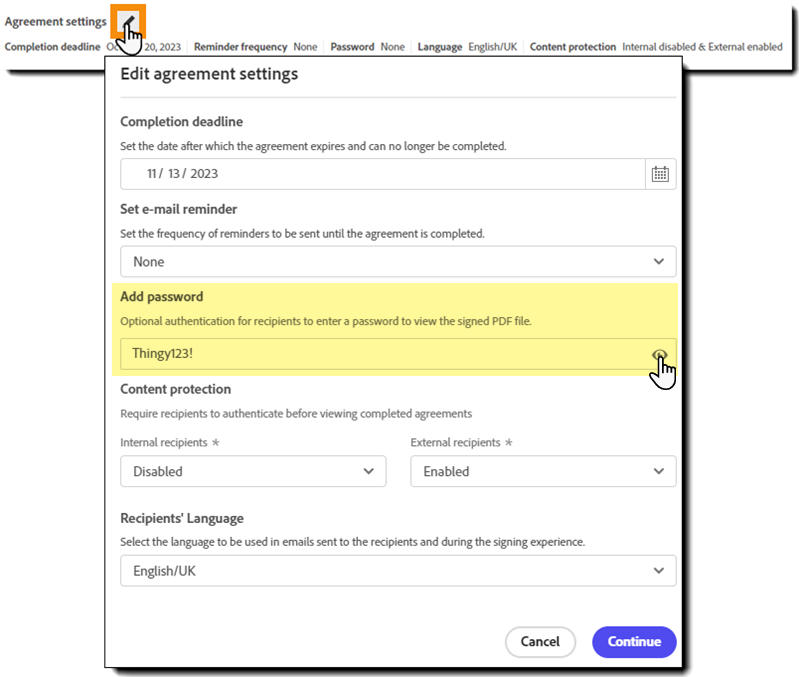

Configure Content Protection.
Content protection installs security to view the agreement agreement after it has been completed. The agreement will require the same authentication method to view as is configured to initially sign the agreement.
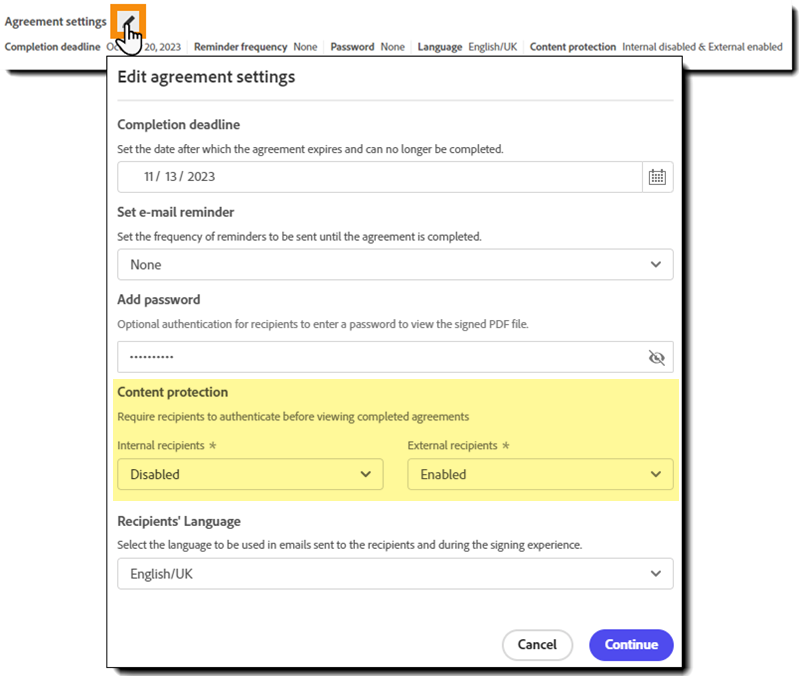

Verify or select a new localization language for the recipient's email.
The Language value indicates the localization for all Acrobat Sign template elements, like labels and instructions, in the recipient email and the e-signing page.
- The default localization is defined in the group settings.
- The default value can be edited (if group settings permit)
- The localization language is a distinct setting from the user's UI settings. It's possible to have the group's UI language set to US English and the group's default signing language set to Japanese.
Edit the Recipient's Language by selecting the Agreement settings edit icon and picking a new language from the dropdown.
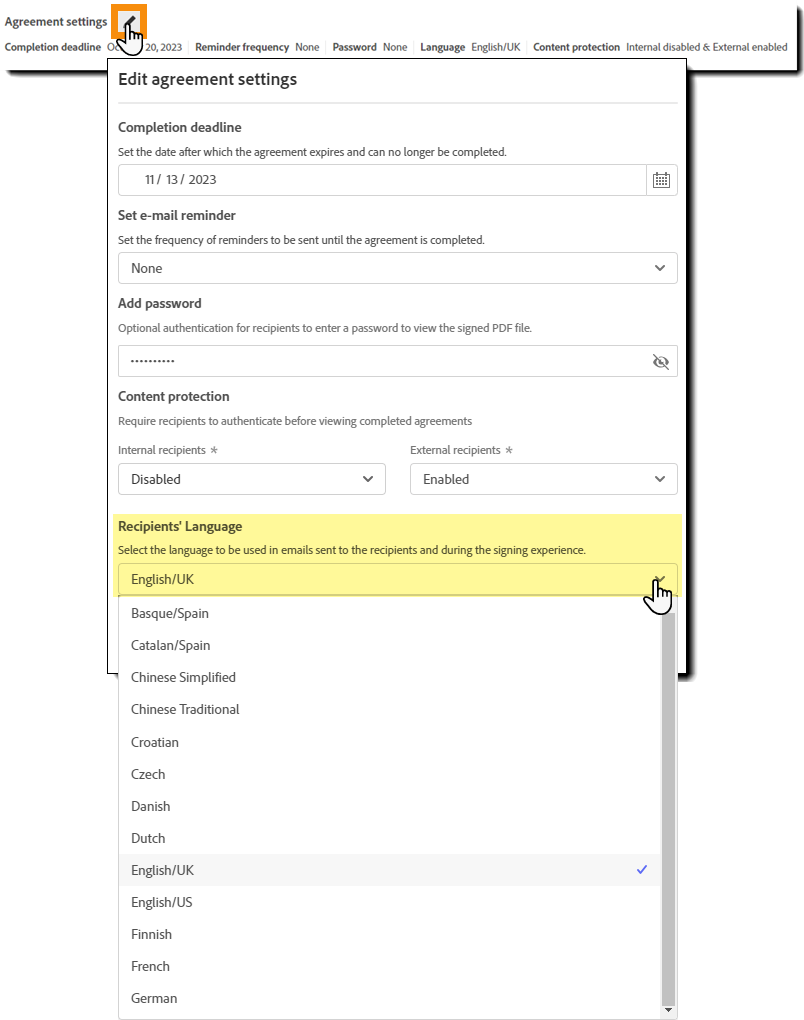

Send in Bulk by using a .CSV file to import the recipients and their details
You can use a CSV file to import your recipients' email addresses and merge custom data into fields on the document for each recipient. You can also customize the message in the email sent to each signer requesting that they sign the document.
.CSV stands for Comma-Separated Value and Excel files can be saved in this format.
This video shows how to set up and use a .CSV file in a Send in Bulk transaction. It also shows how to track the status of all documents sent in the Send in Bulk transaction.
Setting up your .CSV
Before setting up your .CSV, it's necessary to know the names of the fields in your document. There's a different way to do this depending on how you added fields to the document:
- If the document was created with Tags (Text or PDF), use the field name you defined in the tag. For example, has the field name of Address1.
- If you used the Drag and Drop Environment, edit your document and double-click the field. The name of that field is at the top of that properties window.
Once you know the names of the fields on your document, open either the sample found on the Send in Bulk send page, or create an Excel file.
- There must be a minimum of two unique email addresses in the CSV file.
- The sender’s email address cannot be in the CSV.
- The number of transactions that can be generated using the Send in Bulk feature is limited based on the tier of service:
- Enterprise and business tier customers can generate up to 300 transactions
- Acrobat Pro with advanced e‑sign for teams and Adobe Acrobat Sign Professional customers can generate up to 50 transactions
- Acrobat Pro with advanced e‑sign can generate up to 50 transactions
- Team trials can generate up to five transactions
- Enterprise trials can generate up to three transactions
-
The first row is the field names and information tags. For custom fields you've added, add the field names to the column header.
The information tags are as follows:
• _es_signer_email (Mandatory) The signer’s email address
• _es_signer_name (Optional) Signer name used in the signature
• _es_signer_fullname (Optional) Signer name appearing in the document
• _es_signer_company (Optional) Signer Company
• _es_signer_title (Optional) Signer Title
• _es_agreement_message (Optional) The message included in the email sent to the signer.
The other names used (Phone and ZIP code) are the custom fields we've added to the document.
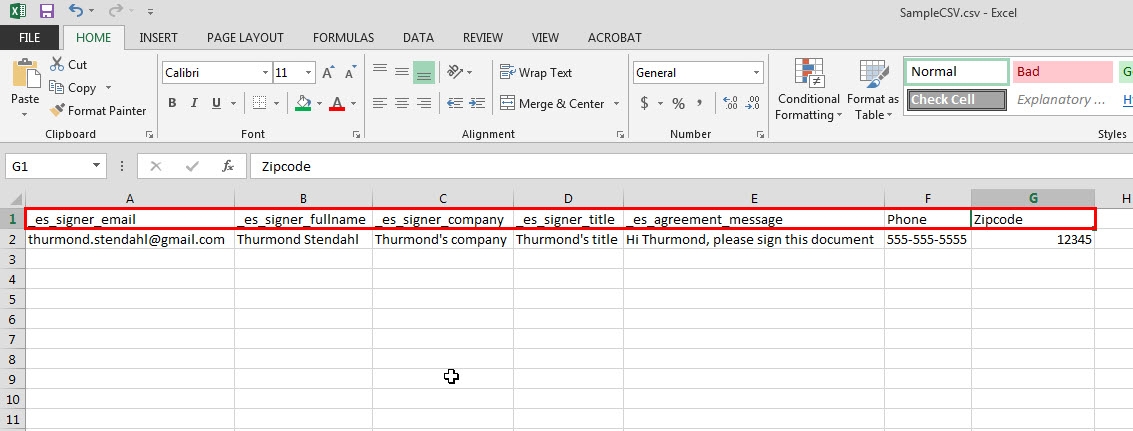

-
The next row is filled with the information specific to the signers. Here we set the email addresses, full name, company name, title, custom message, and the other information for our custom fields.
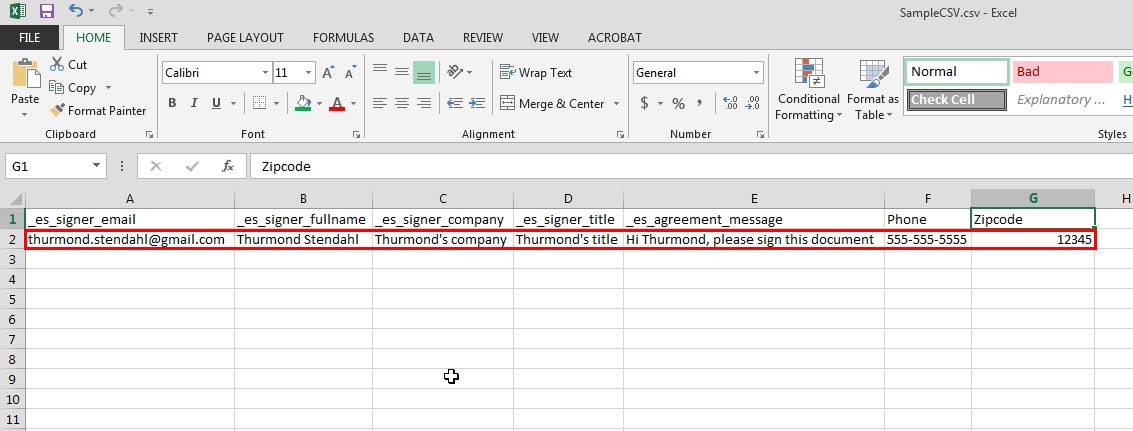

-
Finally, save the file as a .CSV(Comma delimited)(*.csv), to your local system.
- Customers who use double-byte characters must save the CSV file in CSV UTF-8 (Comma delimited)(*.csv) format
- Customers who use double-byte characters must save the CSV file in CSV UTF-8 (Comma delimited)(*.csv) format
Sending using the .CSV
-
Once you've created your .CSV, click Send in bulk on the Home page.
-
On the Send in Bulk send page, click the Import Recipients and Merge Fields from File link to use your .CSV for sending.
-
Click Upload.
-
Find and attach the CSV file you want to use.
-
Configure the other options as desired:
- Identity verification - Set this to apply a second-factor authentication
- I need to sign - Check this box if you (the sender) need to counter sign the documents.
- Agreement Name - The name of the agreement as it appears in the Manage page.
- Message - The global message that is included in the Please Sign email (if no other message is explicitly imported with the .csv).
- Language - What language should be used in the email and on-screen instructions.
- Set an expiration date for this document (Optional) - Defines a number of days that the agreement remains viable before automatically expiring.
- Set password to open signed PDF (Optional) - Defines a password to be applied to secure the signed document.
- Preview, position signatures or add form fields - Allows the sender to place fields on the template.
When done, click Next
NoteA Send in Bulk agreement left in a Prefill or Draft state will automatically expire 24 hours after the creation time.
Adding automatic document expiration
Automatic document expiration allows for account and group level configuration. Expiration can be defined for a default time limit, with an optional setting to permit the sender to edit the default value.
Document expiration is measured in whole days (24-hour increments) starting when the agreement is created. For example, if you configure an agreement for expiration in 3 days, the agreement expires exactly 72 hours after the agreement is sent (if not completed).
Each recipient must complete the signature process before the deadline. Any individual agreement not completed before the deadline is automatically expired.


The account or group administrator can configure document expiration to ignore the expiration deadline if the remaining recipients are internal (counter-signers).















